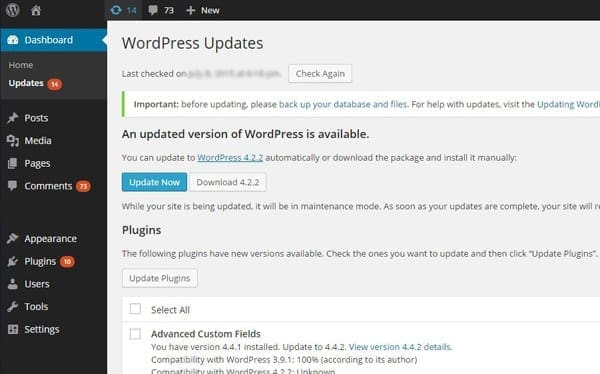Before we get started on why we need to keep your website up-to-date, let’s get to the “why” behind why the updates come about. Updates are made generally to fix incompatibility, security, and bug issues. We can’t forget the most known update, when updating adds more features. If you don’t update your Content Management System (CMS), you might be missing out on fixes, new / fixed features, as well as, leaving yourself open to a security risk.
Why Bug Fixes Are Made
Bug fixes are released because there was some vulnerability in the code that was not caught before. It is easy to miss this because a website’s code might be 10,000+ lines of code long. It’s like watching a movie the 2nd time and catching something you missed before. If you don’t update your CMS, you could be leaving yourself open to be hacked. If you hold customer information, then you have a bigger risk of losing all or a vast majority of your clients if you do get hacked.
Dangers To Update Your CMS
I have 10+ updates and I want to update now! — Hold on there, don’t rush and wildly update your CMS without a plan. Updates come with new / fixed features and they might remove some old features, too. When that happens, and you are updating past a few versions, chances are your site will break. If your site is having issues check out one of our past blogs to help fix it.

What To Do Before Updates
Before you update anything, always make a full backup of your site in case it does go down. Depending on the size of your site it might take a few minutes or a few hours. Once that is done, update the CMS core first. It is the most important part of your site. It is your sites engine and needs to be in top condition. If something is going to break, chances are it will be here.
Now that your site’s core is updated, you need to update any plugins/extensions. If you’re updating more than 1 version, something might break which is why you should do the smart thing and schedule the update to you when your site has the least traffic. You usually start on a Friday and if needed, you then have the weekend to fix it. Just make sure your developer is reachable in case something breaks, so they can reprogram it to minimize downtime.
Lastly, the theme updates. These may get messy and often go against the principle. Updating the theme you are using often isn’t a smart thing to do. When the theme is updated, your custom code (if any) will most likely be removed. This forces you to reprogram much of your site. Generally, themes don’t update often, but if yours has one, back everything up first and then do the update. After any update, look over your site to assure nothing is broken. If everything’s good, then you’re all okay! If something broke, then roll it back to your backup, and notify anyone who would possibly update the site to not do that update.
Conclusion
Even if you have 1 update or 10 updates to make, always make sure to backup your site before each one. Remember, updating it can also cause issues to arise on your site, so be sure to schedule it during your site’s lowest traffic time. By doing that, you will prevent 90% of issues and protect yourself from being hacked. If you are interested in starting a wordpress blog site, check out this article.

Leave a Reply